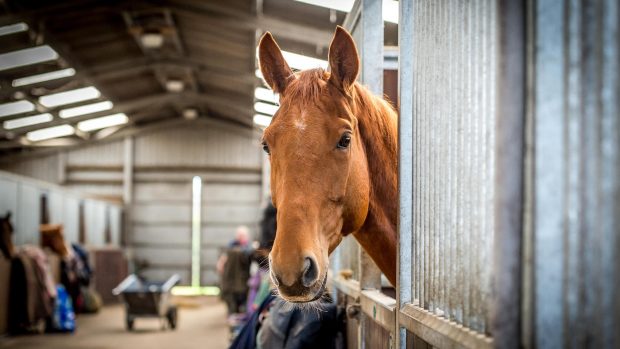Scintigraphy, or bone scanning, involves injecting a radioactive bone-seeking substance (radiopharmaceutical) into the jugular vein. This flows into the blood and is rapidly absorbed by the soft tissues, such as muscle, and finally the bone. After three hours most of the substance will be in the bone, rather than the surrounding soft tissues.
The radioactivity emitted from the horse can be detected using a special camera sensitive to gamma rays which, when linked with a computer, can be displayed on a screen. Images of each area examined are usually taken over a two-minute period.
In order to get high-quality images with no blurring, movement must be avoided as much as possible, which means sedating the horse and restraining it in stocks. Blinkers and ear plugs also help to keep the horse quiet.
Bandages are applied to the limb at least 12hr before injecting the radiopharmaceutical to try to ensure good blood flow and are kept in place until the scans are obtained.
Radiography is excreted in the urine and, legally, horses have to be hospitalised for at least 24hr after the injection, as the urine is potentially dangerous until the radioactivity has decayed.
With recent technology, images can be acquired dynamically and corrections made for any movement. This enhances image quality and sensitivity, particularly when examining the upper limb joints such as the shoulder and the stifle, and also the back, sacroiliac and pelvic regions.
Recognising hot spots
Scintigraphy allows the assessment of blood flow, soft tissue abnormalities and bone function. An increase in blood supply or bone turnover will result in increased absorption of the radiopharmaceutical, producing a “hot spot”.
A more sensitive indicator of abnormalities of bone function than radiography, scintigraphy gives less precise anatomical information than an X-ray.
Modern computer software enables us to evaluate the images quantitatively, so that, if a hot spot is identified, a statistical comparison can be made with the opposite leg, which, in turn, enhances our ability to determine whether the hot spot is likely to be clinically significant. However, a hot spot is not always associated with pain.
Using advanced technology, X-ray images are scanned into a computer and superimposed over a scintigraphic image, to help to determine the precise anatomical location of the hot spot.
The types of clinical situation in which scintigraphy proves invaluable are varied, such as detecting the source of a forelimb lameness, discovering a stress fracture, revealing a large bone cyst or confirming raised levels of muscle enzymes in the blood.
Scintigraphy is not a substitute for a thorough, comprehensive clinical examination, nerve blocks, X-rays or ultrasonography. It is a complementary technique, best used when focused on a specific area.
Some horses, particularly older ones, have poor uptake of the radiopharmaceutical substance. Called a “cold leg”, it makes interpretation difficult. In others, multiple hot spots may be identified which are red herrings and can be misleading.
The technique, therefore, should only be employed as a diagnostic aid as part of an investigation. But it can provide valuable information to achieve a diagnosis which otherwise might not be reached.
- This article was originally published in Horse & Hound magazine




